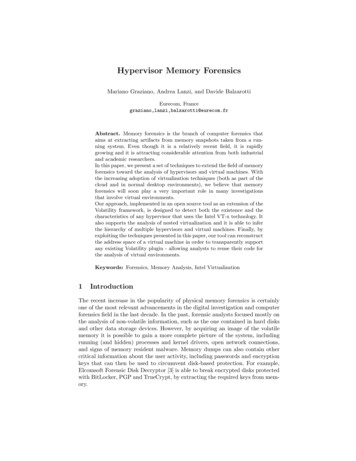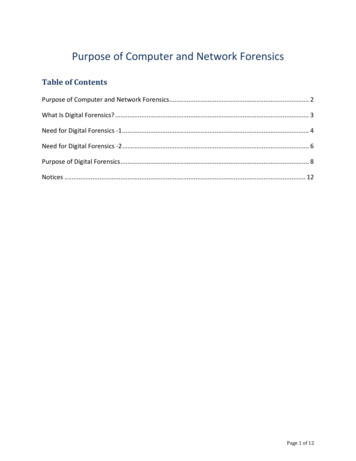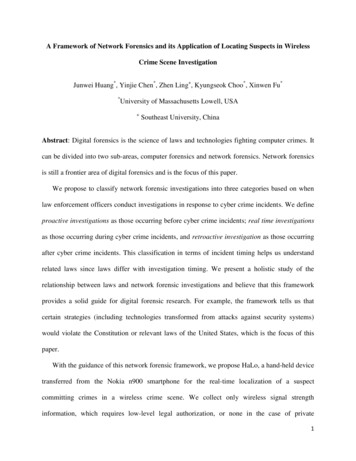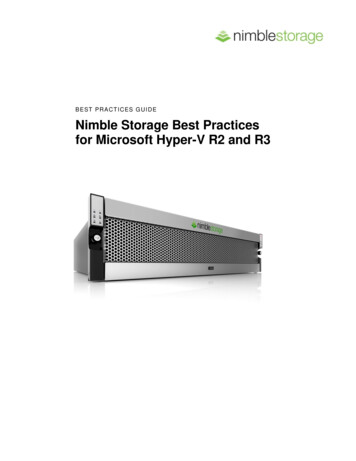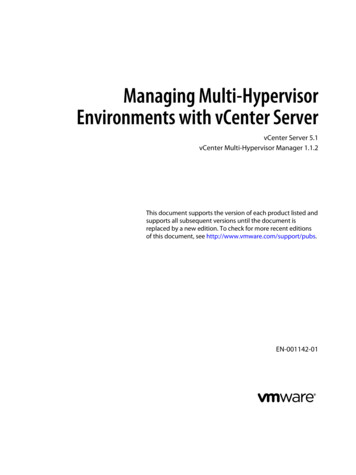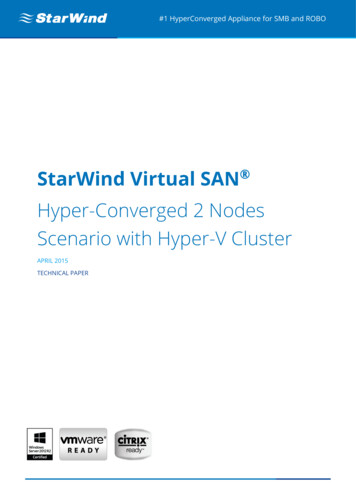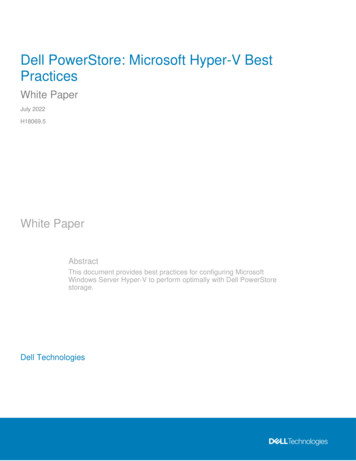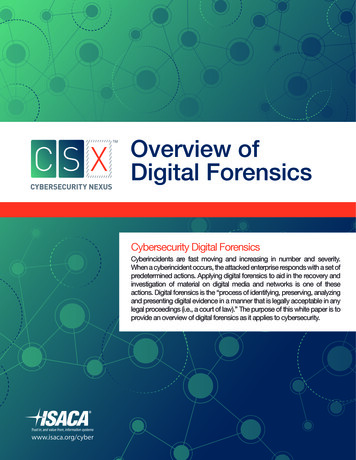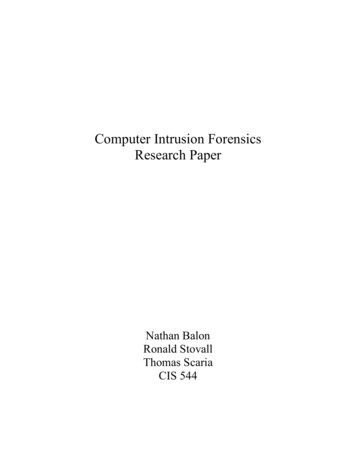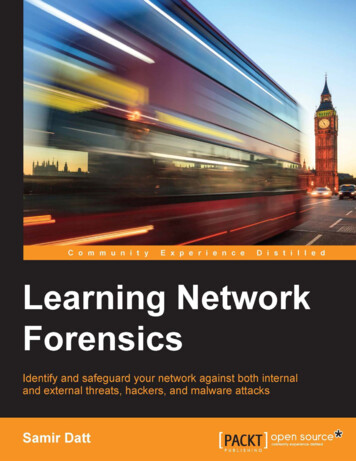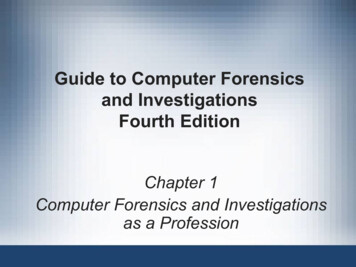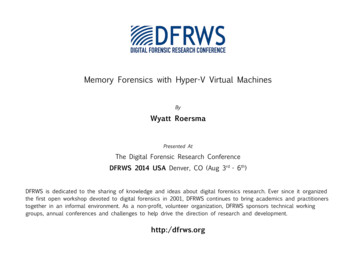
Transcription
DIGITAL FORENSIC RESEARCH CONFERENCEMemory Forensics with Hyper-V Virtual MachinesByWyatt RoersmaPresented AtThe Digital Forensic Research ConferenceDFRWS 2014 USA Denver, CO (Aug 3rd - 6th)DFRWS is dedicated to the sharing of knowledge and ideas about digital forensics research. Ever since it organizedthe first open workshop devoted to digital forensics in 2001, DFRWS continues to bring academics and practitionerstogether in an informal environment. As a non-profit, volunteer organization, DFRWS sponsors technical workinggroups, annual conferences and challenges to help drive the direction of research and development.http:/dfrws.org
Memory Forensics withHyper-V Virtual MachinesBy: @wyattroersma
Who Am I? – Wyatt Roersma NVINT – Senior Security Engineer Mad Security – DFIR challenge creator The Hacker Academy – Content Dev I research for fun Lots of Debug testing for Volatility
Motivation for this Research Better understanding of Hyper-V virtual machines Preform in depth host analysis I work with lots of Hyper-V servers Need for better documentation for Hyper-V forensic analysis Hyper-V accounts for %28 of the hypervisor market share [4]
Agenda Hyper-V Architecture Overview Overview of the Hyper-V Virtual Machine Acquisition tools 2008 – 2012 R2 Hyper-V Host Memory Analysis Conclusions/Q&A
[1]
APIC – Advanced Programmable Interrupt Controller – A device which allows priority levels to be assigned to its interruptoutputs. Child Partition – Partition that hosts a guest operating system - All access to physical memory and devices by a childpartition is provided via the Virtual Machine Bus (VMBus) or the hypervisor. Hypercall – Interface for communication with the hypervisor - The hypercall interface accommodates access to theoptimizations provided by the hypervisor. Hypervisor – A layer of software that sits between the hardware and one or more operating systems. Its primary job is toprovide isolated execution environments called partitions. The hypervisor controls and arbitrates access to the underlyinghardware. IC – Integration component – Component that allows child partitions to communication with other partitions and thehypervisor. I/O stack – Input/output stack MSR – Memory Service Routine Root Partition – Manages machine-level functions such as device drivers, power management, and device hotaddition/removal. The root (or parent) partition is the only partition that has direct access to physical memory and devices.
VID – Virtualization Infrastructure Driver – Provides partition management services, virtual processor management services,and memory management services for partitions. VMBus – Channel-based communication mechanism used for inter-partition communication and device enumeration onsystems with multiple active virtualized partitions. The VMBus is installed with Hyper-V Integration Services. VMMS – Virtual Machine Management Service – Responsible for managing the state of all virtual machines in child partitions. VMWP – Virtual Machine Worker Process – A user mode component of the virtualization stack. The worker process providesvirtual machine management services from the Windows Server 2008 instance in the parent partition to the guest operatingsystems in the child partitions. The Virtual Machine Management Service spawns a separate worker process for each runningvirtual machine. VSC – Virtualization Service Client – A synthetic device instance that resides in a child partition. VSCs utilize hardware resourcesthat are provided by Virtualization Service Providers (VSPs) in the parent partition. They communicate with the correspondingVSPs in the parent partition over the VMBus to satisfy a child partitions device I/O requests. VSP – Virtualization Service Provider – Resides in the root partition and provide synthetic device support to child partitionsover the Virtual Machine Bus (VMBus). WinHv – Windows Hypervisor Interface Library - WinHv is essentially a bridge between a partitioned operating system’s driversand the hypervisor which allows drivers to call the hypervisor using standard Windows calling conventions WMI – The Virtual Machine Management Service exposes a set of Windows Management Instrumentation (WMI)-based APIsfor managing and controlling virtual machines.
Windows Hyper-V Virtual Machine Basics .bin - Physical Memory Chunks .vsv - Memory Metadata .xml – Virtual Machine Config
.xml – Hyper-V Virtual Machine Configuration
.bin - Physical Memory Chunks.vsv - Memory Metadata
Acquisition Tools: Windows Server 2008 -2008R2Vm2dmp.exe archive.msdn.microsoft.com/vm2dmp - no longer works Used to convert saved state files (.vsv .bin)into a crashdumpRequirements: Windows Debugging toolsProblems: 4GB RAM or more will cause the VM2DMP “ERROR: Failed to mapguest block 4096 to any saved state block! ERROR: Element notfound.”Doesn't support saved Linux virtual machines
Examples: Create a dump file using virtual machine state files: vm2dmp.exe -bin C:\dir\ VM-Instance-ID.bin -vsv C:\VM\ VM-Instance-ID.vsv dmp C:\dir\crashdump.dmp Create a dump file from virtual machine and snapshot name: vm2dmp.exe –vm VMName -dmp C:\VM\crashdump.dmp vm2dmp.exe –vm VMName –snap “vm VMName -snap-SP1” -dmpC:\VM\crashdump.dmp Note: If you have a downloaded path of the debugging symbols then you canspecify –sym and then the directory of the symbols path.
Acquisition Tools: Windows Server 2012 -2012R2Livekd.exe aspx Converts live, saved, and snap shot files to windows crash dumpformatCons: No Linux System Support Windows APILiveDump.exe available/
Examples: If you want to list the virtual machines on the server just use the –hvloptions and it will list GUIDs and names of running Hyper-V VM’s. livekd.exe –hvl If you want to create a full crash dump of a virtual machine running on thehost system you would run livekd.exe –hv (System name or GUID) –p (to pause the system to create a moreconsistent image) –o (output-file) livekd.exe –hv AD –p –o AD.dmp
Hyper-V Host Memory Analysis Host Memory dumps 148GB Checking Host VM’s for Artifacts Virtual Firewall Analysis All Traffic Live on the host Network Artifacts
[3]
Virtual Machine Worker Processpython vol.py -f HV2012R2.raw --profile Win2012R2x64 psscan grep vmwp.exeVolatility Foundation Volatility Framework 2.4 (Beta)0x000000000cd7c100 vmwp.exe3740 1504 0x00000000b73a5000 2014-08-03 21:42:06 UTC 00000x000000002223a080 vmwp.exe2380 1504 0x0000000111eb3000 2014-08-03 20:41:03 UTC 00000x00000000fa742900 vmwp.exe1952 1504 0x00000000bc856000 2014-08-03 21:42:07 UTC 00000x00000001cab2a900 vmwp.exe808 1504 0x00000001f80fc000 2014-08-04 05:21:35 UTC 0000
Security Onion VM Artifactsgrep -i "sovm-eth1" ps-strings.txt grep ET19851536 [FREE MEMORY] 0 2 network-scan sovm-eth1 {2014-07-22 18:31:19} 3 3697 {ET TOR Known TorRelay/Router (Not Exit) Node Traffic group 226} 192.42.116.161 10.0.0.103 6 9001 49987 1 2522450 1913 1918191819851824 [FREE MEMORY] 0 2 network-scan sovm-eth1 {2014-07-22 18:31:19} 3 3700 {ET TOR Known TorRelay/Router (Not Exit) Node Traffic group 18} 176.10.100.227 10.0.0.103 6 989 49983 1 2522034 1913 1921 192119852256 [FREE MEMORY] 0 2 network-scan sovm-eth1 {2014-07-22 18:31:19} 3 3701 {ET TOR Known Tor ExitNode Traffic group 18} 176.10.100.227 10.0.0.103 6 989 49983 1 2520034 1913 1922 1922
Pfsense FWgrep -i "pfsense" ps-strings.txtsnip 2525873247 [FREE MEMORY] Jul 21 16:03:23 pfSense dnsmasq[19767]: reading /etc/resolv.conf2525873312 [FREE MEMORY] Jul 21 16:03:23 pfSense dnsmasq[19767]: using nameserver 208.67.220.220#532525873387 [FREE MEMORY] Jul 21 16:03:23 pfSense dnsmasq[19767]: using nameserver 208.67.222.222#53snip
2468293085 [FREE MEMORY] Aug 3 20:42:47 pfSense kernel: FreeBSD 8.3-RELEASE-p16 #0: Fri Jun 20 13:19:29 EDT 20142468293174 [FREE MEMORY] Aug 3 20:42:47 pfSense kernel:root@pf2 1 1 c/sys/pfSense SMP.8 amd642468293295 [FREE MEMORY] Aug 3 20:42:47 pfSense kernel: Timecounter "i8254" frequency 1193182 Hz quality 02468293378 [FREE MEMORY] Aug 3 20:42:47 pfSense kernel: CPU: Intel(R) Xeon(R) CPU E5-2630 0 @ 2.30GHz (1653.76-MHzK8-class CPU)2468293483 [FREE MEMORY] Aug 3 20:42:47 pfSense kernel: Origin "GenuineIntel" Id 0x206d7 Family 6 Model 2dStepping 7Snip 2468293932 [FREE MEMORY] Aug 3 20:42:47 pfSense kernel: AMD Features2 0x1 LAHF 2468293988 [FREE MEMORY] Aug 3 20:42:47 pfSense kernel: TSC: P-state invariant2468294043 [FREE MEMORY] Aug 3 20:42:47 pfSense kernel: real memory 1073741824 (1024 MB)2468294111 [FREE MEMORY] Aug 3 20:42:47 pfSense kernel: avail memory 1009954816 (963 MB)2468294178 [FREE MEMORY] Aug 3 20:42:47 pfSense kernel: ACPI APIC Table: VRTUAL MICROSFT 2468294245 [FREE MEMORY] Aug 3 20:42:47 pfSense kernel: FreeBSD/SMP: Multiprocessor System Detected: 2 CPUs2468294329 [FREE MEMORY] Aug 3 20:42:47 pfSense kernel: FreeBSD/SMP: 1 package(s) x 2 core(s)2468294399 [FREE MEMORY] Aug 3 20:42:47 pfSense kernel: cpu0 (BSP): APIC ID: 02468294455 [FREE MEMORY] Aug 3 20:42:47 pfSense kernel: cpu1 (AP): APIC ID: 1Snip
Conclusion/Q&A Firewall, Switch, and Router Memory Analysis? Hyper-V recap Watch my blog for more information wyattroersma.com Useful Plugin? Vmwp? Questions?
References: [1] http://msdn.microsoft.com/en-us/library/cc768520(v bts.10).aspx [2] http://csis.gmu.edu/VMSec/presentations/Hyper-V Security Baker.ppt [3] https://www.ernw.de/wp-content/uploads/ERNW Newsletter 43 HyperV en.pdf [4] ket/2014-01-07 t DC 2011 Suiche Cloud%20Pocket-Slides.pdf eference22#imagecopy http://www.wyattroersma.com/?p 87 http://www.wyattroersma.com/?p 77 http://hypervking.info/hyper-v-tools/ 1-0-is-available/
The VMBus is installed with Hyper-V Integration Services. VMMS -Virtual Machine Management Service -Responsible for managing the state of all virtual machines in child partitions. VMWP -Virtual Machine Worker Process -A user mode component of the virtualization stack. The worker process provides
